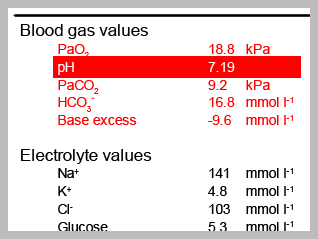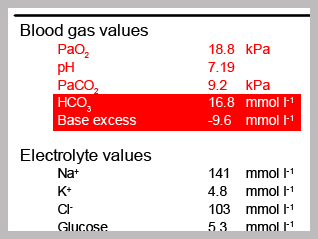
- Summary
You have reached the end of this topic on arterial blood gas analysis. Recap on the 5-step approach that should be used when analysing ABG results.
Consider the following.
Consider the following.
Cell 1

Step one – how is the patient?
The first step is to always check how the patient is. This patient has told the attending nurse that he is feeling increasingly short of breath and has severe central chest pain. He has been started on 85% oxygen by face mask.
The first step is to always check how the patient is. This patient has told the attending nurse that he is feeling increasingly short of breath and has severe central chest pain. He has been started on 85% oxygen by face mask.
Cell 2
![A picture of a patient’s ABG printout with the PaO [sub]2[/sub] circled.](images/m35_t05_015_2.png)
Step two – is the patient hypoxaemic?
Next you should check the patient’s PaO2 levels. This patient’s PaO[sub]2[/sub] is in the normal range, but is less than would be expected breathing 85% oxygen.
Next you should check the patient’s PaO2 levels. This patient’s PaO[sub]2[/sub] is in the normal range, but is less than would be expected breathing 85% oxygen.
Cell 3

Step three – is the patient acidaemic (pH <7.35) or alkalaemic (pH> 7.45)?
This patient’s ABG results show that this patient is acidaemic.
This patient’s ABG results show that this patient is acidaemic.
Cell 4
![A picture of a patient’s ABG printout with the PaCO [sub]2[/sub]circled.](images/m35_t05_015_4.png)
Step four – what happened to the PaCO2?
This patient’s PaCO[sub]2[/sub] level is increased suggesting that he has a respiratory acidosis.
This patient’s PaCO[sub]2[/sub] level is increased suggesting that he has a respiratory acidosis.
Cell 5

Step five – what has happened to the base excess (BE) and bicarbonate?
This patient’s bicarbonate and base excess (BE) are both reduced suggesting that he also has a metabolic acidosis.
This patient’s bicarbonate and base excess (BE) are both reduced suggesting that he also has a metabolic acidosis.
Select Menu to return to the main menu.
References
See chapter 15 of the ALS manual for further reading about arterial blood gas analysis.
Essentials: The 5-step approach
Step one – how is the patient?
Step two – is the patient hypoxaemic?
Step three – is the patient acidaemic or alkalaemic?
Step four – what happened to the PaCO2?
Step five – what has happened to the base excess (BE) or bicarbonate?
Settings
Font colour
default inverted high contrast high contrast inverted high contrast soft green on blackSample text
text looks like thisTEXT LOOKS LIKE THIS
